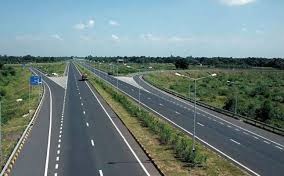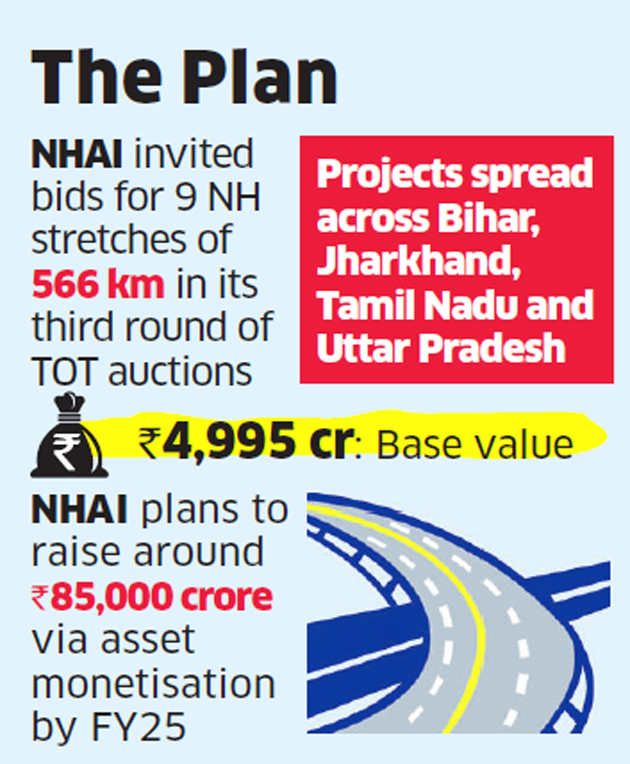
Toll Operate Transfer (TOT)

Toll Operate Transfer (TOT)
|
For Prelims: Toll Operate Transfer, Significance, Aim, National Highways Authority of India(Objectives) |
Why in the news?
The National Highways Authority of India (NHAI) recently awarded two highway monetisation projects worth Rs 6,584 in the toll, operate, and transfer (TOT) mode.
About the Toll Operate Transfer (TOT) Model:
- In 2016, the Cabinet Committee on Economic Affairs (CCEA) authorized the National Highway Authority of India (NHAI) to monetise public-funded national highway projects and approved the ToT model.
- The upfront payments made by concessionaires in the TOT model provide the government with immediate funds, serving as a crucial financial source for future highway development and maintenance.
- These funds play a pivotal role in sustaining and enlarging the national highway network by supporting the construction of new highways and ensuring the continuous upkeep of existing ones, even in regions that might not be financially viable.
- In the TOT model, public-funded projects, operational for two years, are put up for bidding, wherein the right of collection and appropriation of fees is assigned for a predetermined concession period (30 years) to concessionaires (developers or investors) against the upfront payment of a lump sum amount to NHAI.
- Such assignment of rights shall be based on the toll revenue potential of the identified NH projects.
- Operation & Maintenance (O&M) obligations of such projects shall be with the concessionaire till the completion of the concession period.
- The concessionaires for such projects shall be appointed through a transparent and uniform procurement process within the ambit of a pre-defined and approved implementation framework.

Significance
- It will help in the utilization of the corpus (generated from proceeds of such project monetisation) by the Government to meet fund requirements for future development and O&M of highways in the country, including in unviable geographies.
- The TOT model has been developed to encourage private participation in the Highway sector.
TOT model aims
- to reduce dispute for extension of concession period by providing extension upon material default or breach committed by Authority, leading to suspension of, or reduction (i.e. less than 90% of 'Average Daily Fee') in collection of, 'Fee', as provided in the TOT model.
It is also provided that:
(i) Upon termination of the arrangement due to default by the concessionaire, the Authority shall forfeit performance security, but pay 70% of 'Unexpired Cash Flow' to the concessionaire.
(ii) Upon termination due to default by Authority, the concessionaire shall be paid an amount equal to 105% of the Unexpired Cash Flow, subject to lenders (if any) issuing NOC, failing this such payment shall be made by Authority directly to such lenders.
The TOT model provides flexibility to Parties to neutralize the effect of any:
- (i) increase in costs
- (ii) reduction in net after-tax return
- (iii) other financial burden, suffered by either of the Parties due to 'Change of Law'.
To reduce the allegation/ probability of biasness in settlement of disputes, arising between Parties, TOT model provides for reference thereof to Society for Affordable Redressal of Disputes (SAROD) for arbitration, which was incorporated in 2013, by NHAI, and National Highways Builders Federation (NHBF), an apex organization of all contractors/ builders of NHs, state highways and bridges in India.
National Highways Authority of India (NHAI)
- It is an autonomous agency of the Government of India, responsible for the management and development of the national highways network in the country.
- It was established in 1988 under the National Highways Authority of India Act, 1988.
- It is under the administrative control of the Union Ministry of Road Transport and Highways.
- It is headed by a chairman, who is assisted by six full-time members and four part-time members. The chairman and the members are appointed by the Central Government.
Objectives of NHAI
- Plan, develop, construct, operate and maintain national highways and expressways in India.
- Regulate and control the use of national highways and expressways for traffic and safety purposes.
- Collect tolls and fees for the use of national highways and expressways and utilize the revenues for their maintenance and improvement.
- Coordinate with the state governments and other agencies for the development of inter-state and international road connectivity.
- Promote research and development in the field of highway engineering and technology.
Source: Times of India